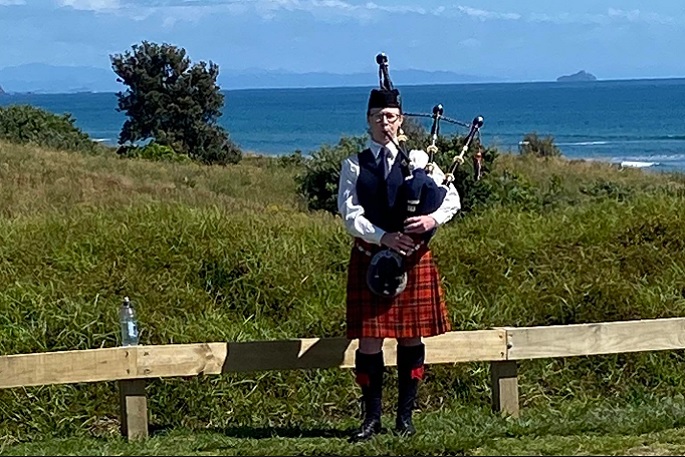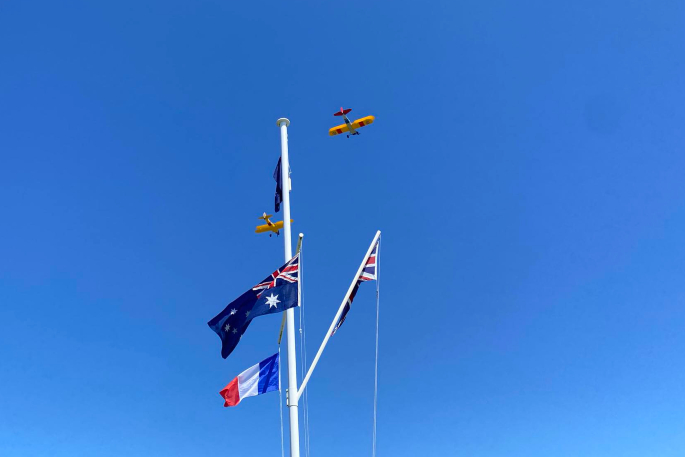The flag is still flying high at the Pāpāmoa War Memorial following well-attended Armistice Day commemorations on Saturday across Tauranga and Western Bay of Plenty.
Armistice Day, later known as Remembrance Day, commemorates the 11th hour of the 11th day of the 11th month, when the guns fell silent and an agreement was made to end the fighting of the First World War.
Tauranga RSA had a series of events planned at the Tauranga RSA Cenotaph, starting 11 am with the unfurling of a flag and two minutes’ silence followed by an invite to attend the Members Bar for morning tea.
Te Puke RSA had a small gathering at the building near the flag pole with finger food morning tea afterwards.
In Katikati, the Katikati RSA solemnly remembered those who had served during the war from their community.
“It’s a pretty special day for us,” says Katikati RSA president Glen Burt.
“We had 19 people who went from Katikati who never returned. That’s quite a big number for a little town that many years ago.”
The ceremony at the Katikati War Memorial Hall began with Returned Service Association members arriving at about 10.45am with the service starting just before 11am and concluding about 11.20am.
 Piper Libby Munro at Pāpāmoa. Photo: Supplied.
Piper Libby Munro at Pāpāmoa. Photo: Supplied.
In Pāpāmoa the Pāpāmoa War Memorial Trust organised an Armistice Day Service which Mount Maunganui RSA members were also welcome to attend.
Held at Stella Place, the community and in particular young people were invited, with a muster of veterans, NZDF personnel and community service organisations also attending, arriving around 10.30am in the horse paddock nearby. Representatives of the British and Australian High Commissions attended and spoke and a wreath was laid on behalf of the people and government of France.
“The service was well attended and as usual Pāpāmoa Collage students were amazing,” says Michael O’Carroll.
Following the parade to the cenotaph lead by piper Libby Munro, five students from Pāpāmoa College led by teacher-in-charge Sarah Jacob came forward to give ‘The Great War by Numbers’, provided by trustee Martin Elliott who was also the MC for the commemoration.
 Planes from Classic Flyers passed overhead during the commemoration at Pāpāmoa. Photo: Supplied.
Planes from Classic Flyers passed overhead during the commemoration at Pāpāmoa. Photo: Supplied.
The Great War by Numbers
Setting the Scene: New Zealand in 1914
In 1914 New Zealand was a fledgling young country of just over one million people; of whom 40 per cent were immigrants and not born in New Zealand.
700,000 or 70 per cent identified as European New Zealanders; 16 per cent or 49,000 as Maori New Zealanders; and the remainder were Asian or Pacifica New Zealanders.
New Zealand was an agrarian farming economy and most New Zealanders lived in small towns and rural areas; Maori in particular were rural dwellers with 90 per cent living within their rohe.
50 per cent of New Zealand’s population were aged under 40.
These numbers set the scene for the disaster that was about to unfold for New Zealand in The Great War
2014- 2018 The War Years
During the years 1914 to 1918 more than 120,000 New Zealanders enlisted to fight in The Great War with England and her allies. Of the 100,000 military who served overseas most were in the army; but there were also those who were in the navy and air force. 550 women served primarily as nurses – 18 were killed in action.
In total this equates to 10 per cent of New Zealand’s total population or 20 per cent of the male population who served in the Great War overseas.
Most were young men and nearly one in five who served abroad did not return. This meant one in four of New Zealand’s men aged 20-45 were either killed or wounded in the Great War
Around 18,000 died in, or because of the War; from wounds or disease, and about 41,000 were listed as wounded.
To give a modern-day appreciation of these statistics, the number of soldiers who died in the Great War equates to every man woman and child in Whakatane in 2023. The number of soldiers wounded equates to 60 per cent of Rotorua’s population.
An incidental catastrophe was that when the troops returned to New Zealand in 1918, they brought with them the virulent Spanish Flu which killed 8,600 people and decimated the Maori population. To put that figure into context, 3,393 New Zealanders have died from Covid since 2019.
The Gallipoli campaign
The campaign to invade the Dardenelles was one of New Zealand’s first major World War 1 campaigns. It is thought that between 16,000 and 18,000 New Zealanders landed at Gallipoli in 1915 as part of a combined allied offensive of 480,000 soldiers. Research data varies, but it is estimated that between 2721 and 2843 New Zealanders died during the Gallipoli campaign, of whom 1909 were killed in action, 606 died of wounds, 200 died of sickness, and six died of ‘other causes’.
The Somme and Messine Offensive
It is thought that 18,000 New Zealanders fought at the Somme. Military Historian Andrew Macdonald puts the total casualty figure at 7959, comprising 2111 dead and 5848 wounded between 31 August and 25 October 1916.
He therefore assesses the casualty rate at 53 per cent of the 15,000 men who began the campaign.
Andrew bases his death figure on a study of individual deaths during the campaign, omitting men who died of illness or injury unrelated to the Somme offensive.
Military Historian Douglas Carbery estimated that there were 3633 casualties at Messines in the seven days between June 7- 13, 1917; including 473 killed, 2726 wounded, and 434 missing.
Many of the missing would later be counted among the dead.
Passchendaele
Military Historian Douglas Carbery quotes a total casualty number of 6078 for October 1917 - the month of the Broodseinde and Passchendaele offensives during the Third Battle of Ypres, during which 1536 men were killed or died of wounds, 233 were reported missing and 4309 were wounded.
Historian Andrew Macdonald extends the end date to November 14 to include late-reported casualties and puts the total at 8832, of whom 1796 died. His death figure is based on the number of New Zealand soldiers who died in Belgium during October 1917, according to the Commonwealth War Graves database. This total will include some men who died of illness and injury unrelated to the Passchendaele offensive, while others injured at Passchendaele will have died in hospital in France.
The fighting at Passchendaele made October 12 New Zealand’s worst day in any overseas war, with around 843 dead killed in action. More fatalities than New Zealand has annual deaths from automobile accidents.
 Students from Pāpāmoa College. Photo: Supplied.
Students from Pāpāmoa College. Photo: Supplied.
Laying of wreaths
Following the reading of ‘The Great War by Numbers, a Pāpāmoa College student read the poem ‘In Flanders Fields’. Wreaths were then laid at the cenotaph by RSA personnel, and representatives of countries each accompanied by a PāpāmoaCollege student. Community wreaths were also laid.
As the Last Post was played, the flags were lowered to half mast, the Ode was recited, the flags were raised once again and following concluding comments, NZ’s National Anthem was sung in Re Reo and English.
“The Pāpāmoa War Memorial Trust would like to hear from any possible sponsors who can help us with our services in the future,” says Michael O’Carroll.



0 comments
Leave a Comment
You must be logged in to make a comment.